Table of Contents
What is Stress?
Stress refers to a psychological and physiological state that results when certain features of an individual’s environment challenge that person, creating or actual or perceived imbalance between demand and capability to adjust that results in a non-specific response.
Definition of Stress
Stress, or the stress response, is the unconscious preparation to fight or flee a person experiences when faced with any demand.
J. C Quick and J.D Quick
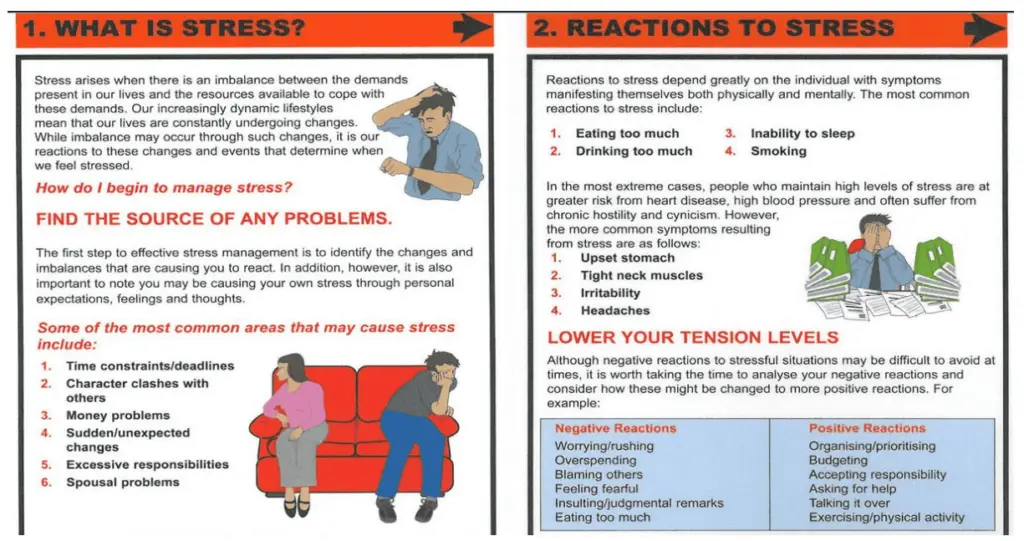
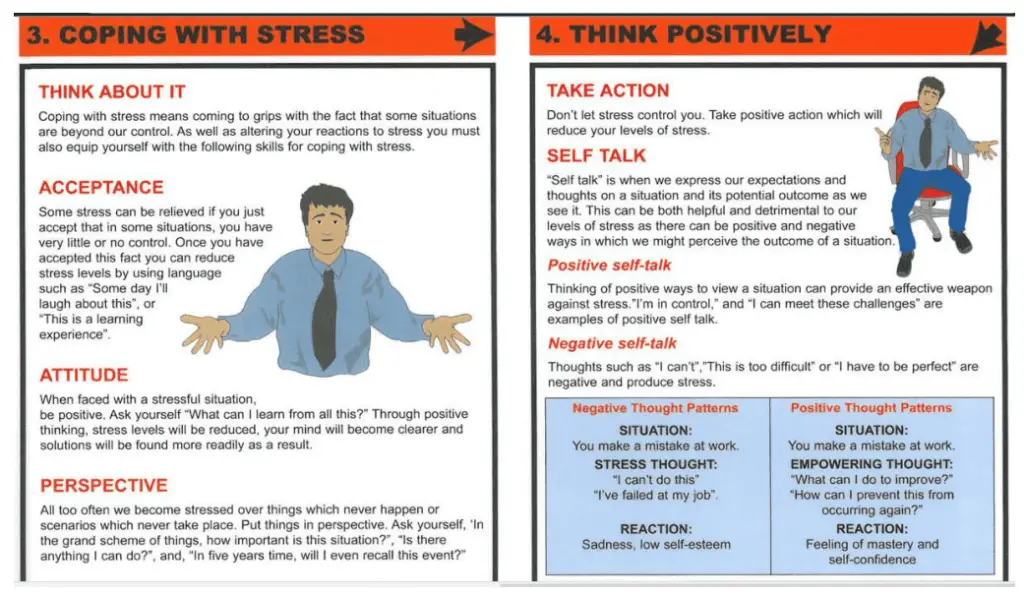
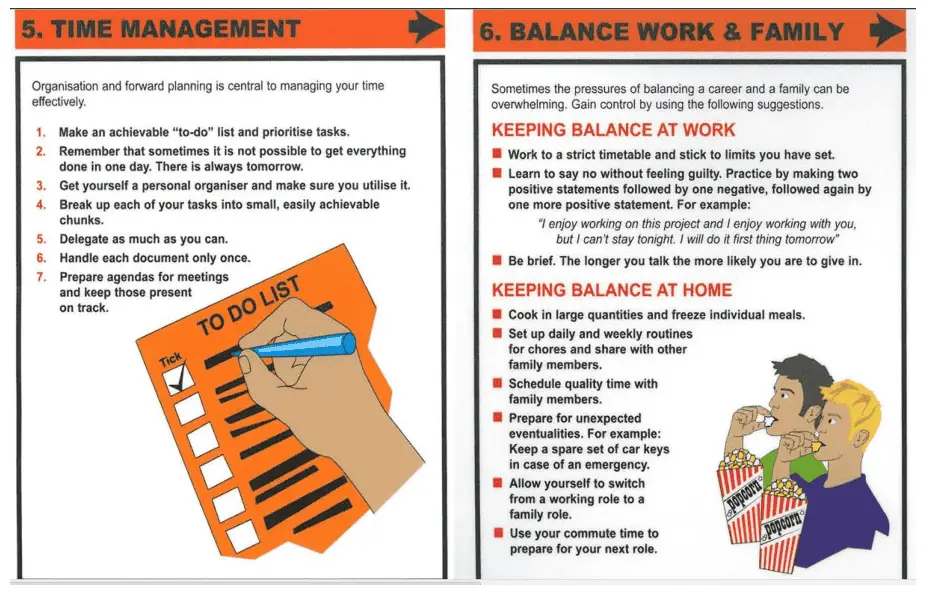
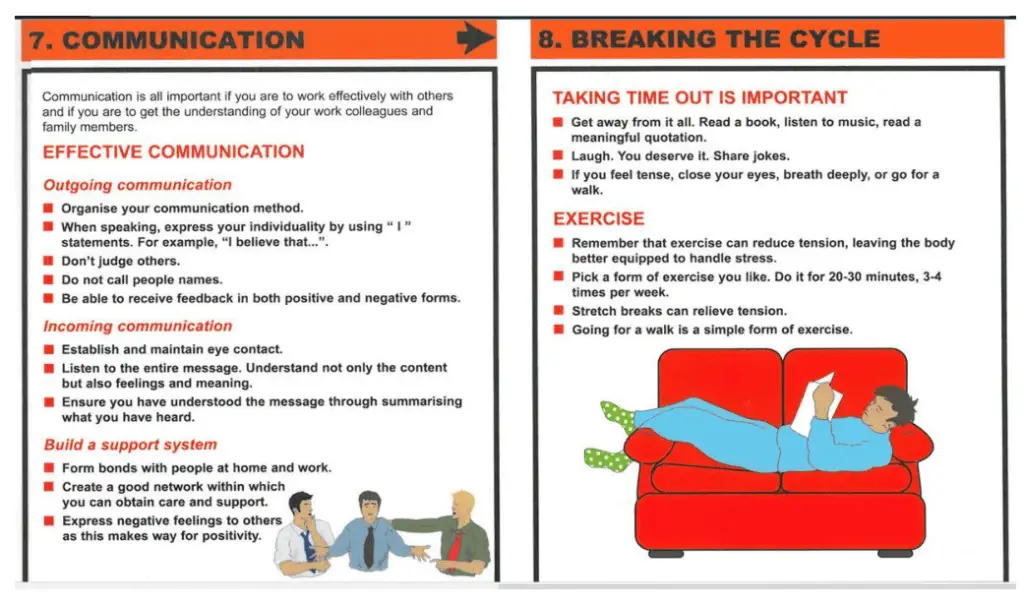
Types of Stress
Stress can manifest itself in a number of ways depending upon the suddenness of an event to be dealt with and the types of stressors to be handled by an individual. It may manifest itself either physically, emotionally, or mentally, as certain symptoms. The types of stress are explained below:
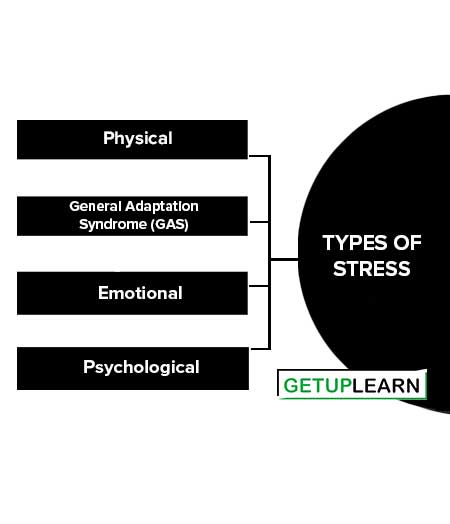
Physical
This happens when the body as a whole suffers due to a stressful situation. There are many symptoms like, headaches, and tension in the neck, forehead, and shoulder muscles Long periods of stress can cause other serious symptoms like digestive problems, ulcers, insomnia (sleeplessness), fatigue, high blood pressure, nervousness, excessive sweating, heart ailments, strokes, and hair loss as well.
General Adaptation Syndrome (GAS)
Hans Selye, the world’s foremost authority on stress was the first to describe systematically the changes through which the body passes to deal with a perceived threat, he described what he called the General Adaptation Syndrome (GAS), an adaptive response that occurs in three phases:
- An alarm reaction.
- The stage of resistance;
- The stage of exhaustion. The figure below shows the course of the General Adaptation Syndrome.

The above diagram shows the course of the General Adaptation Syndrome (GAS) and describes the psychological and physical response to stress -that is, the way a person tries to adapt to a stressor. The syndrome is called “general” because the stress response occurs in several areas of the body. GAS has 3 stages.
-
Alarm Stage: According to this model, the general adaptation syndrome begins when a person encounters a stressor and enters the alarm stage. A person in this stage wonders how to cope and feels anxiety, even panic. The person breathes faster, blood pressure rises, pupils dilate and muscles tense. At this stage, the person is coping ineffectively.
-
Resistance: Assuming the person can summon the resources to cope with the stressor, he or she begins to feel more confident and to think of how to respond. During the second stage of the general adaptation syndrome, “resistance”, the person channels his or her energy and uses it to resist the stressor’s negative effects. The person tackles the problem, delegates the challenge, or adjusts to the change. Resistance to the stressor is high, but the person’s resistance to other stressors may be low because the body’s resources are being used up. Evidence shows that a person’s immune system function tends to decline during periods of stress.
- Exhaustion: Many stressors are short-term: The person manages to solve the problem, or the situation ends on its own. In such cases, the general adaptation syndrome ends during the resistance stage. But occasionally, a stressor persists. In situations where stressors persist, the person may enter the third stage: exhaustion. In this stage, the symptoms of the alarm stage return and the person eventually uses up his or her adaptive energy.
Emotional
These responses are due to stress affecting the mind and include, anxiety, anger, depression, irritability, frustration, over-reaction to everyday problems, memory loss, and a lack of concentration for any task. Anxiety is exhibited as a response to loss, failure, danger, or a fear of the unknown.
Anger is a response to frustration or social stress and can become a danger to other individuals, if not kept in check. Depression is frequently seen as an emotional response to upsetting situations, such as the death of a loved one, illness, and failure.
Psychological
Long-term stress can cause psychological problems in some individuals. Symptoms may include social isolation, phobias, compulsive behaviors, eating disorders, and night terrors.
Potential Sources of Stress
While environmental factors are forces outside the organization, which may act as potential sources of stress due to uncertainties and threats that they create for any organization and its members, factors within the organization can also act as potential sources of stress.
Together or singly they may create a tense and volatile working environment which can cause stress for organizational members because of the inability of individuals to handle the pressures arising out of these sources. For purposes of analysis and understanding, stressors are divided into two classes:
- Those that lie within the individual,
- Those that are a part of the external environment.
These are the potential sources of stress:
- Inner Conflicts
- Perceptual Influences
- Thresholds of Stress
- Motivational Level
- Task Demands
- Role Demands
- Inter-Personal Demands
- Physical Demands

Internal Stimuli for Stress
The internal sources of stress are complex and difficult to isolate. There are three internal sources of stress. Each of these internal influences on stress is considered separately, although they function in continual interaction.
Inner Conflicts
For many people, stress is a constant companion regardless of how favorable or unfavorable external conditions may be. Non-specific fears, anxiety, and guilt feelings maintain the body in a state of readiness for emergency action on a continuing basis.
- Conflict in interpersonal relationships,
- Bankruptcy/Money Problems
- Unemployment
- Children’s problems at school
- Legal problems
Perceptual Influences
Perception is influenced by a number of internal factors. Certainly, people with inner conflicts sufficient to cause stress are more likely than self-confident people to perceive environmental conditions as threatening.
Because the environment is presumed to be full of danger, evidence of danger is perceived everywhere. They are selectively perceived in an exaggerated form.
Thresholds of Stress
The threshold of stress is not independent of the two factors just discussed. People who have few internal conflicts and a minimum of perceptual distortion can withstand external conflict and pressure that weaker personalities would find intolerable. People who have high thresholds for stress have high levels of resistance to it.
Motivational Level
People who are ambitious and highly motivated to achieve are more likely to experience stress than those who are content with their career status. Persons whose selt-expectations exceed their abilities and opportunities are especially stress-prone.
Environmental and Internal Stressors
Environmental and internal conditions that lie beyond an individual’s control are called environmental stressors. Such stressors can have a considerable impact on work performance and adjustment. We can organize environmental stressors into the following categories:
Task Demands
Task demands are factors related to a person’s job. They include the design of the individual’s JOD, working conditions, and the physical work layout. Changes and lack of control are two of the most stressful demands people face at work.
Change leads to uncertainty, and a lack of predictability in a person’s daily tasks and activities, and may be caused by job insecurity related to difficult economic times. Technology and technological innovation also create change and uncertainty for many employees, requiring adjustments in training, education, and skill development.
Role Demands
The social-psychological demands of the work environment may be every bit as stressful as task demands at work. Role demands relate to pressures placed on a person as a function of the particular role he or she plays in the organization.
Role conflicts create expectations that may be hard to reconcile or satisfy. Role conflict results from inconsistent or incompatible expectations communicated to a person. The conflict may be an inter-role, intra-role or person-role conflict.
-
Inter-Role Conflict: is caused by conflicting expectations related to two separate roles, such as employee and parent. For example, an employee with a major sales presentation on Monday and a sick child at home is likely to experience inter-role conflict.
-
Intra-Role Conflict: is caused by conflicting expectations related to a single role, such as employee. For example, the manager who presses employees for both very fast work and high-quality work may be viewed at some point as creating a conflict for employees.
- Person-Role Conflict: Ethics violations are likely to cause person-role conflicts. Employees expected to behave in ways that violate personal values, beliefs or principles experience conflict.
Inter-Personal Demands
All pressures created by other employees, lack of social support from colleagues, and poor interpersonal relationships can cause considerable stress, especially among employees with a high social needs. Abrasive personalities, sexual harassment, and the leadership style in the organization are interpersonal demands for people at work.
-
The Abrasive Person: Maybe an able and talented employee, but one who creates emotional waves that others at work must accommodate.
-
Sexual Harassment: The vast majority of sexual harassment is directed at women in the workplace, creating a stressful working environment for the person being harassed, as well as for others.
- Leadership Styles: Whether authoritarian or participative, create stress for different personality types. Employees who feel secure with firm, directive leadership may be anxious with an open, participative style. Those comfortable with participative leadership may feel restrained by a directive style.
Physical Demands
Non-work demands create stress for people, which carries over into the work environment or vice versa. Workers subject to family demands related to marriage, child-rearing, and parental care may create role conflicts or overloads that are difficult to manage.
In addition to family demands, people have personal demands related to non-work organizational commitments such as religious and public service organizations. These demands become more or less stressful, depending on their compatibility with the person’s work and family life and their capacity to provide alternative satisfactions for the person.
Consequences of Stress
Stress shows itself in three ways-physiological, psychological, and behavioral symptoms:
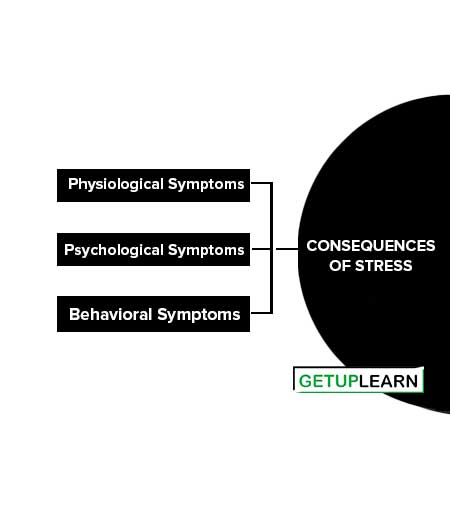
Physiological Symptoms
Most of the early concern with stress was directed at physiological symptoms due to the fact that specialists in the health and medical sciences researched the topic. Physiological symptoms have the least direct relevance to students of OB.
Psychological Symptoms
- Job-related stress can cause job-related dissatisfaction.
- Job dissatisfaction is “the simplest and most obvious psychological effect” of stress (Robbins, 2003).
- Multiple and conflicting demands, and lack of clarity as to the incumbent’s duties, authority, and responsibilities, increase stress and dissatisfaction.
- The less control people have over the pace of their work, the greater the stress and dissatisfaction.
Behavioral Symptoms
Behaviourally related stress symptoms include changes in productivity, absence, and turnover, as well as changes in eating habits, increased smoking or consumption of alcohol, rapid speech, fidgeting, and sleep disorders.
Strategies to Manage Stress
While many of the methods of preventing stress need to be developed and supported by the organization, there are things that workers can do to help you better manage” stress. Here are 10 tips for dealing with the stress from your job. Let’s look at the tips or strategies to manage stress:
- Put it in Perspective
- Modify Your Job Situation
- Get Time Away
- Fight Through Clutter
- Talk it Out
- Cultivate Allies at Work
- Find Humor in Situation
- Have Realistic Expectations
- Nobody is Perfect
- Maintain a Positive Attitude

Put it in Perspective
Jobs are disposable. Your friends, families, and health are not. If your employer expects too much of you, and it’s starting to take its toll on you, start looking for a new job/new employer.
Modify Your Job Situation
If you really like your employer, but the job has become too stressful (or too boring), ask about tailoring your job to your skills. And if you got promoted into a more stressful position that you just are not able to handle, ask about a lateral transfer – or even a transfer back to your old job (if that’s what you want).
Get Time Away
If you feel the stress building, take a break. Walk away from the situation, perhaps walking around the block, sitting on a park bench, taking in a little meditative time. Exercise does wonders for the psyche. But even just finding a quiet place and listening to your iPod can reduce stress.
Fight Through Clutter
Taking the time to organize your desk or workspace can help ease the sense of losing control that comes from too much clutter. Keeping a to-do list – and then crossing things off it also helps.
Talk it Out
Sometimes the best stress reducer is simply sharing your stress with someone close to you. The act of talking it out – and getting support and empathy from someone else is often an excellent way of blowing off steam and reducing stress. Have a support system of trusted people.
Cultivate Allies at Work
Just knowing you have one or more co-workers who are willing to assist you in times of stress will reduce your stress level. Just remember to reciprocate and help them when they are in need.
Find Humor in Situation
When you or the people around you start taking things too seriously, find a way to break through with laughter. Share a joke or funny story.
Have Realistic Expectations
While Americans are working longer hours, we can still only fit so much work into one day. Having unrealistic expectations for what you can accomplish sets you up for failure and increased stress.
Nobody is Perfect
If you are one of those types that obsess over every detail and micromanage to make sure “everything is perfect,” you need to stop. Change your motto to performing your best, and leave perfection to the gods.
Maintain a Positive Attitude
Maintain a positive attitude (and avoid those without one). Negativism sucks the energy and motivation out of any situation, so avoid it whenever possible. Instead, develop a positive attitude and learn to reward yourself for little accomplishments (even if no one else does).from too much clutter. Keeping a to-do list and then crossing things off it also helps.
FAQs Section
What are the potential sources of stress?
These are the potential sources of stress:
1. Inner Conflicts
2. Perceptual Influences
3. Thresholds of Stress
4. Motivational Level
5. Task Demands
6. Role Demands
7. Inter-Personal Demands
8. Physical Demands.
What are the strategies to manage stress?
The following are the strategies to manage stress:
1. Put it in Perspective
2. Modify Your Job Situation
3. Get Time Away
4. Fight Through Clutter
5. Talk it Out
6. Cultivate Allies at Work
7. Find Humor in the Situation
8. Have Realistic Expectations
9. Nobody is Perfect
10. Maintain a Positive Attitude.
